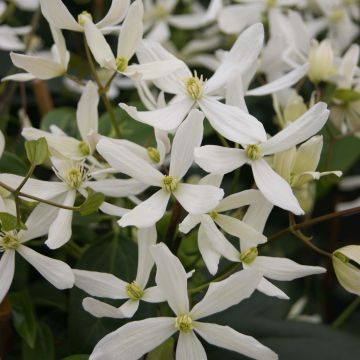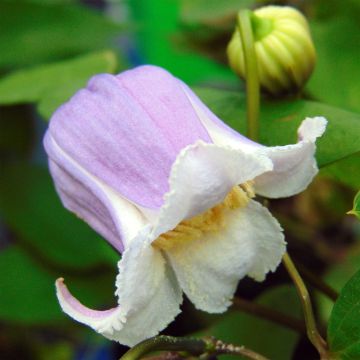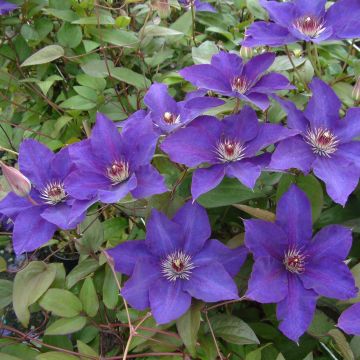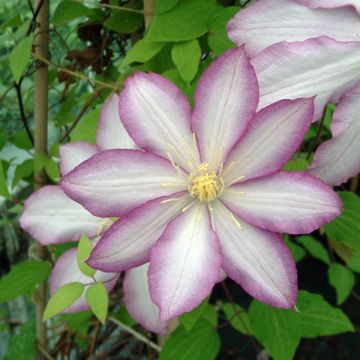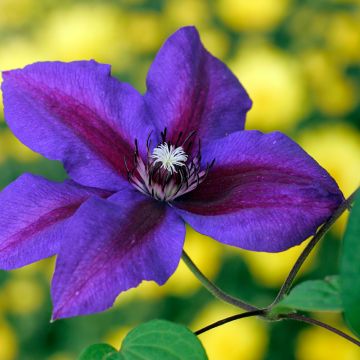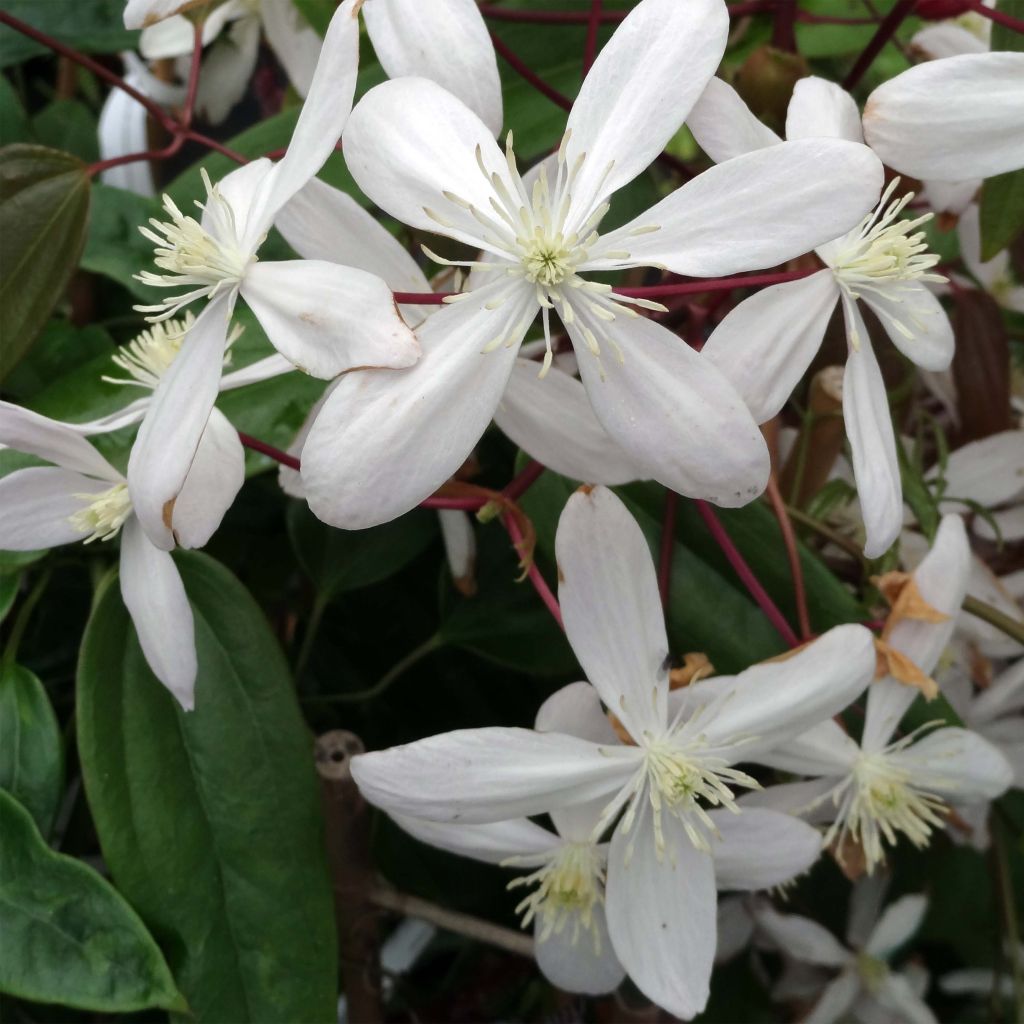

Clematis armandii Hendersonii Rubra - Evergreen Clematis
Clematis armandii Hendersonii Rubra - Evergreen Clematis
Clematis armandii Hendersonii Rubra
Armand Clematis, Evergreen Clematis
It took her 2 seasons to establish herself. And after a tiny and very disappointing growth in the first year, she's making up for it. I hope to see her bloom this year.
Sarah, 10/03/2023
Special offer!
Receive a €20 voucher for any order over €90 (excluding delivery costs, credit notes, and plastic-free options)!
1- Add your favorite plants to your cart.
2- Once you have reached €90, confirm your order (you can even choose the delivery date!).
3- As soon as your order is shipped, you will receive an email containing your voucher code, valid for 3 months (90 days).
Your voucher is unique and can only be used once, for any order with a minimum value of €20, excluding delivery costs.
Can be combined with other current offers, non-divisible and non-refundable.
Home or relay delivery (depending on size and destination)
Schedule delivery date,
and select date in basket
This plant carries a 6 months recovery warranty
More information
We guarantee the quality of our plants for a full growing cycle, and will replace at our expense any plant that fails to recover under normal climatic and planting conditions.

Would this plant suit my garden?
Set up your Plantfit profile →
Description
The Armand's Clematis Hendersonii Rubra is a more purple form of Armand's Clematis, on which the red colour can be seen at different levels, from the young shoots to the small pink flowers carried by blood-red peduncles. This vigorous liana is one of the few evergreen clematis, which are also more sensitive to cold than deciduous species. Its early flowering, with divinely scented cascades of pink flowers, with notes of orange blossom and vanilla, begins in late winter in the south of our country, and truly explodes in March-April. One of the best uses for this beautiful clematis is to plant it in a large hedge of bushes on which it will take support, and which, at the same time, will hide the dead and brown leaves that remain attached to the branches for a long time.
Armand's Clematis is a persistent, robust, and floriferous Chinese botanical species capable of quickly covering large areas. Originally from central and western China, it was introduced to Europe by Ernest Wilson in 1900. The cultivar 'Hendersonii Rubra', born in the late 1950s, selected and introduced in California by the experimental gardens of Henderson, stands out for its strong red colouration in certain parts of its vegetation, its darker and shinier leaves, and its more intensely colored rose flowers, especially on the reverse side. These plants belong to the Ranunculaceae family.
'Hendersonii Rubra' produces quadrangular woody climbing stems that grow from its stump, reaching a minimum length of 4 to 5 meters (13 to 16 feet), with the same vigor as the species. Over time, this liana will cover more than 3.50 meters (11 feet) in width on the ground. Vegetation starts again at the end of February, with the appearance of large dark red floral buds. They quickly swell and elongate to open into large clusters of pink-purple buds carried by shiny red peduncles. Each bud gives rise to a 5-6 cm (2in) diameter flower, composed of 4 white tepals more or less tinged with pink, with a dark pink reverse side, surrounding a heart of cream and green stamens. Their pronounced, powerful, sweet scent resembles that of orange blossom and almond. After flowering, it is the brown-red young shoots that develop on the branches. They unfold into leaves divided into 3 large, deeply veined, very glossy, dark green leaflets. These leaves are so firmly attached to the stems that they have difficulty detaching themselves when they dry. Large dark brownish-black areas then form, more or less hidden under the young foliage. It may be useful to remove these dead leaves for aesthetic reasons only.
This Hendersonii Rubra clematis is not very hardy and does not tolerate cold winters well, especially in heavy soil and windy exposures. Plant it up to the Paris region to cover a well-exposed, very sunny wall, where it can withstand short frosts of around -12/-15°C (10.4/5°F) once established. However, it is a star of Mediterranean gardens, just like the banksia roses with which it pairs well: it perfectly withstands dry and hot summers after 2 to 3 years of careful cultivation and care, provided it is well established in a deep, well-prepared, amended, and loosened soil. It is best to avoid letting it climb a pergola or arbor for two reasons: its evergreen foliage blocks the sun in winter, and its dry foliage, which accumulates under the vegetation, is not very aesthetic. But the beauty of this liana, as well as the intoxicating scent of its flowers, are well worth a few minutes of meticulous pruning once a year.
Report an error about the product description
Clematis armandii Hendersonii Rubra - Evergreen Clematis in pictures




Plant habit
Flowering
Foliage
Botanical data
Clematis
armandii
Hendersonii Rubra
Ranunculaceae
Armand Clematis, Evergreen Clematis
Cultivar or hybrid
Other Clematis A to Z
View all →Planting and care
In a sunny exposure, shade the base of your Clematis Hendersonii Rubra with a ground cover plant or a perennial geranium. Clematis like to have their feet in the cool soil and their heads in the sun. This one is quite sensitive to cold, but can withstand short freezes of around -12 to -15°C (10.4 to 5°F) in healthy soil and in a sheltered position from dry and cold winds. It tolerates being planted in the dense shade of a tree or a large bush that it will climb to bloom in the sun. Armand's Clematis prefers deep and loose soils, and tolerates the presence of limestone. Take care when planting: install your plant by covering the root ball with 3 cm (1in) of soil, in soil worked to a depth of 20-30 cm (8-12in), lightened with good compost. During the first few weeks, water abundantly and regularly. Monitor watering during the first 2 or 3 summers, in hot and dry weather: water generously, but very infrequently (once a week or once every 2 weeks depending on the weather conditions). Clematis attach themselves thanks to their petioles transformed into tendrils. To guide their growth, provide them with a trellis support or let them dress up the trunk of a tree by placing a mesh. Clematis also like to grow freely on neighboring plants. In the north and east of France, its success is a bit random; it must be planted in a very sunny location and well protected from cold winter winds. Mulch the soil and the liana will help it withstand occasional temperatures below -12°C (10.4°F).
Planting period
Intended location
Care
-
, onOrder confirmed
Reply from on Promesse de fleurs
Similar products
Haven't found what you were looking for?
Hardiness is the lowest winter temperature a plant can endure without suffering serious damage or even dying. However, hardiness is affected by location (a sheltered area, such as a patio), protection (winter cover) and soil type (hardiness is improved by well-drained soil).

Photo Sharing Terms & Conditions
In order to encourage gardeners to interact and share their experiences, Promesse de fleurs offers various media enabling content to be uploaded onto its Site - in particular via the ‘Photo sharing’ module.
The User agrees to refrain from:
- Posting any content that is illegal, prejudicial, insulting, racist, inciteful to hatred, revisionist, contrary to public decency, that infringes on privacy or on the privacy rights of third parties, in particular the publicity rights of persons and goods, intellectual property rights, or the right to privacy.
- Submitting content on behalf of a third party;
- Impersonate the identity of a third party and/or publish any personal information about a third party;
In general, the User undertakes to refrain from any unethical behaviour.
All Content (in particular text, comments, files, images, photos, videos, creative works, etc.), which may be subject to property or intellectual property rights, image or other private rights, shall remain the property of the User, subject to the limited rights granted by the terms of the licence granted by Promesse de fleurs as stated below. Users are at liberty to publish or not to publish such Content on the Site, notably via the ‘Photo Sharing’ facility, and accept that this Content shall be made public and freely accessible, notably on the Internet.
Users further acknowledge, undertake to have ,and guarantee that they hold all necessary rights and permissions to publish such material on the Site, in particular with regard to the legislation in force pertaining to any privacy, property, intellectual property, image, or contractual rights, or rights of any other nature. By publishing such Content on the Site, Users acknowledge accepting full liability as publishers of the Content within the meaning of the law, and grant Promesse de fleurs, free of charge, an inclusive, worldwide licence for the said Content for the entire duration of its publication, including all reproduction, representation, up/downloading, displaying, performing, transmission, and storage rights.
Users also grant permission for their name to be linked to the Content and accept that this link may not always be made available.
By engaging in posting material, Users consent to their Content becoming automatically accessible on the Internet, in particular on other sites and/or blogs and/or web pages of the Promesse de fleurs site, including in particular social pages and the Promesse de fleurs catalogue.
Users may secure the removal of entrusted content free of charge by issuing a simple request via our contact form.
The flowering period indicated on our website applies to countries and regions located in USDA zone 8 (France, the United Kingdom, Ireland, the Netherlands, etc.)
It will vary according to where you live:
- In zones 9 to 10 (Italy, Spain, Greece, etc.), flowering will occur about 2 to 4 weeks earlier.
- In zones 6 to 7 (Germany, Poland, Slovenia, and lower mountainous regions), flowering will be delayed by 2 to 3 weeks.
- In zone 5 (Central Europe, Scandinavia), blooming will be delayed by 3 to 5 weeks.
In temperate climates, pruning of spring-flowering shrubs (forsythia, spireas, etc.) should be done just after flowering.
Pruning of summer-flowering shrubs (Indian Lilac, Perovskia, etc.) can be done in winter or spring.
In cold regions as well as with frost-sensitive plants, avoid pruning too early when severe frosts may still occur.
The planting period indicated on our website applies to countries and regions located in USDA zone 8 (France, United Kingdom, Ireland, Netherlands).
It will vary according to where you live:
- In Mediterranean zones (Marseille, Madrid, Milan, etc.), autumn and winter are the best planting periods.
- In continental zones (Strasbourg, Munich, Vienna, etc.), delay planting by 2 to 3 weeks in spring and bring it forward by 2 to 4 weeks in autumn.
- In mountainous regions (the Alps, Pyrenees, Carpathians, etc.), it is best to plant in late spring (May-June) or late summer (August-September).
The harvesting period indicated on our website applies to countries and regions in USDA zone 8 (France, England, Ireland, the Netherlands).
In colder areas (Scandinavia, Poland, Austria...) fruit and vegetable harvests are likely to be delayed by 3-4 weeks.
In warmer areas (Italy, Spain, Greece, etc.), harvesting will probably take place earlier, depending on weather conditions.
The sowing periods indicated on our website apply to countries and regions within USDA Zone 8 (France, UK, Ireland, Netherlands).
In colder areas (Scandinavia, Poland, Austria...), delay any outdoor sowing by 3-4 weeks, or sow under glass.
In warmer climes (Italy, Spain, Greece, etc.), bring outdoor sowing forward by a few weeks.
































